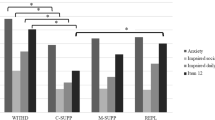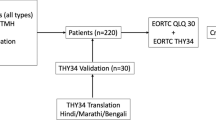Abstract
Goals
When thyroid and other cancers are "cured" it is often assumed that the patients are able to resume their normal lives. This was a cross-sectional study to evaluate health-related quality of life (HRQOL) and to identify rehabilitation needs of patients with non-metastatic thyroid cancer under thyroxine supplementation therapy.
Patients and methods
Included in the study were 150 consecutive patients with differentiated thyroid cancer (age 52±14 years, range 25–83 years; male/female 39/111). All patients had a history of total thyroidectomy followed by radioiodine ablation, were free of metastatic disease and under levothyroxine treatment. The mean period since the diagnosis of thyroid cancer was 5.5±6 years (range 0–23 years). Health-related quality of life was evaluated using the SF-36 Health Survey. The findings were compared with sex- and age-matched reference values.
Results
"Role-emotional" and "Vitality" were significantly lower (P<0.001 and P<0.005, respectively) in the group as a whole (n=150). In the subgroup of patients with a recent (less than 1 year) diagnosis of thyroid cancer (n=51), however, the following subscales were significantly lower: "Mental Health" (P<0.01), "Role-emotional" (P<0.001), "Role-physical" (P<0.005), "Social functioning" (P<0.005) and "Vitality" (P<0.001). Multiple regression analysis identified a significant positive correlation between "Mental Health", "Physical functioning", "Vitality", "Role-emotional" and "Social functioning" with the time since initial diagnosis, and there was also a positive correlation between "Physical functioning", "Bodily pain" and "Role-emotional" with male gender.
Conclusions
These findings indicate that "Vitality", "Role-physical", "Mental Health", "Role-emotional" and "Social functioning" are significantly impaired during the first year after diagnosis. Thereafter, quality of life improves correlating with the time since initial diagnosis. However, "Vitality" and "Role-emotional" remain permanently impaired in thyroid cancer patients. A multidisciplinary rehabilitation concept should include psychological support and an early start to exercise to improve physical performance of these patients leading to better HRQOL and to help them fulfill their social role earlier.
Similar content being viewed by others
References
Aistars J (1987) Fatigue in the cancer patient: a conceptual approach to a clinical problem. Oncol Nurs Forum 14:25–30
Apolone G, Filiberti A, Cifani S, Ruggiata R, Mosconi P (1998) Evaluation of the EORTC QLQ-C30 questionnaire: a comparison with SF-36 Health Survey in a cohort of Italian long-survival cancer patients. Ann Oncol 9:549–557
Baker F, Haffer SC, Denniston M (2003) Health-related quality of life of cancer and noncancer patients in Medicare managed care. Cancer 97:674–681
Brook RH, Ware JE, Davies-Avery A, Stewart AL, Donald CA, Rogers WH, Williams KN, Johnston SA (1979) Overview of adult health status measures fielded in Rand's health insurance study. Med Care [Suppl] 17:1–55
Bullinger M (1996) Erfassung der gesundheitsbezogenen Lebensqualität mit dem SF-36 Health Survey. Rehabilitation (Stuttg) 35:17–27
Capelli G, De Vincenzo RI, Addamo A, Bartolozzi F, Braggio N, Scambia G (2002) Which dimensions of health-related quality of life are altered in patients attending the different gynecologic oncology health care settings? Cancer 95:2500–2507
Chan CW, Molassiotis A (2001) The impact of fatigue on Chinese cancer patients in Hong Kong. Support Care Cancer 9:18–24
Coates A (1997) Quality of life and supportive care. Support Care Cancer 5:435–438
Courneya KS, Keats MR, Turner AR (2000) Physical exercise and quality of life in cancer patients following high dose chemotherapy and autologous bone marrow transplantation. Psychooncology 9:127–136
Crevenna R, Schmidinger M, Keilani MY, Nuhr M, Wiesinger GF, Korpan M, Marosi C, Fialka-Moser V, Quittan M (2002) Aerobic exercise for breast cancer patients receiving adjuvant oncological treatment—results of the first Austrian outpatient group. Phys Med Rehab Kuror 12:25–30
Crevenna R, Fialka-Moser V, Keilani M, Schmidinger M, Marosi C, Quittan M (2002) Aerobic exercise for a patient suffering from relapsed inflammatory breast cancer. Wien Med Wochenschr 152:581–584
Crevenna R, Keilani M, Schmidinger M, Bittner C, Nur H, Marosi C, Fialka-Moser V, Quittan M (2002) Aerobic exercise for cancer patients. Wien Med Wochenschr (in press)
Crevenna R, Schmidinger M, Keilani M, Nuhr M, Nur H, Fialka-Moser V, Quittan M (2002) Aerobic exercise as additive palliative treatment for a patient with advanced hepatocellular cancer. Wien Med Wochenschr (in press)
Crevenna R, Schmidinger M, Keilani M, Nuhr M, Fialka-Moser V, Zettinig G, Quittan M (2003) Aerobic exercise for a patient suffering from metastatic bone disease. Support Care Cancer 11:120–122
Davis AM, O'Sullivan B, Bell S, Turcotte R, Catton Cn, Wunder JS, Chabot P, Hammond A, Benk V, Isler M, Freeman C, Goddard K, Bezjak A, Kandel RA, Sadura A, Day A, James K, Tu D, Pater J, Zee B (2002) Function and health status outcomes in a randomized trial comparing preoperative and postoperative radiotherapy in extremity soft tissue sarcoma. J Clin Oncol 20:4472–4477
Dimeo F, Fetscher S, Lange W, Mertelsmann R, Keul J (1997) Effects of aerobic exercise on the physical performance and incidence of treatment-related complications after high-dose chemotherapy. Blood 90:3390–3394
Dimeo F, Rumberger BG, Keul J (1998) Aerobic exercise as therapy for cancer fatigue. Med Sci Sports Exerc 30:475–478
Dimeo FC, Stieglitz RD, Novelli-Fischer U, Fetscher S, Keul J (1999) Effects of physical activity on the fatigue and psychologic status of cancer patients during chemotherapy. Cancer 85:2273–2277
Dow KH, Ferrell B, Leigh S, Ly J, Gulasekaram P (1996) An evaluation of the quality of life of long term survivors of breast cancer. Breast Cancer Res Treat 39:261–273
Dow KH, Ferrell BR, Anello C (1997) Quality-of-life changes in patients with thyroid cancer after withdrawal of thyroid hormone therapy. Thyroid 7:613–619
Dow KH, Ferrell BR, Anello C (1997) Balancing demands of cancer surveillance among survivors of thyroid cancer. Cancer Pract 5:289–295
Ferrans CE (1990) Development of a quality of life index for patients with cancer. Oncol Nurs Forum 17 [3 Suppl]:15–19; discussion 20–21
Ferrell B, Dow KH (1997) Quality of life among long-term cancer survivors. Oncology 11:565–571
Fobair P, Hoppe RT, Bloom J, Cox R, Varghese A, Spiegel D (1986) Psychosocial problems among survivors of Hodgkin's disease. J Clin Oncol 4:805–814
Fraker D, Skarulis M, Livolsi V (1996) Thyroid tumors. In: DeVita V, Hellman S, Rosenberg S (eds) Cancer: principles and practice of oncology, 5th edn. Lippincott-Raven, Philadelphia, pp 1629–1652
Gupta KL (1995) Neoplasm of the thyroid gland. Clin Geriatr Med 11:271–290
Holm S (1979) A simple sequentially rejective multiple test procedure. Scand J Statist 6:65–70
Johnson JB, Kelly AW (1990) A multifaceted rehabilitation program for women with cancer. Oncol Nurs Forum 17:691–695
Kaplan M (1990) Progress in thyroid cancer. Endocrinol Metab Clin North Am 19:469–478
Kaserer K, Scheuba C, Neuhold N, Weinhausel A, Haas OA, Vierhapper H, Niederle B (2001) Sporadic versus familial medullary thyroid microcarcinoma: a histopathologic study of 50 consecutive patients. Am J Surg Pathol 25:1245–1251
Livsey JE, Routledge J, Burns M, Swindell R, Davidson SE, Cowan RA, Logue JP, Wylie JP (2002) Scoring of treatment-related late effects in prostate cancer. Radiother Oncol 65:109–121
MacVicar MG, Winningham ML, Nickel JL (1989) Effects of aerobic interval training on cancer patients' functional capacity. Nurs Res 38:348–351
Martinsen EW, Medhus A, Sandvik L (1985) Effects of aerobic exercise on depression: a controlled study. BMJ 291:109
Meier C, Bravermann L, Ebner S, Veronikis I, Daniels G, Ross D, Deraska D, Davies T, Valentine M, DeGroot L, Curran P, McEllin K, Reynolds J, Robbins J, Weintraub B (1994) Diagnostic use of recombinant human thyrotropin in patients with thyroid carcinoma (phase I/II study). J Clin Endocrinol Metab 76:188–196
Moinpour C (1994) Measuring quality of life: an emerging science. J Clin Oncol 5:48–63
Morrow GR, Andrews PL, Hickok JT, Roscoe JA, Matteson S (2002) Fatigue associated with cancer and its treatment. Support Care Cancer 10:389–398
Mucha C, Belaouchi N (1998) Psychische Effekte von Sport und Bewegungstherapie-eine Literaturanalyse. Physikalische Therapie 19:598–602
Osoba D (2000) Health-related quality-of-life assessment in clinical trials of supportive care in oncology. Support Care Cancer 8:84–88
Passler C, Scheuba C, Prager G, Kaserer K, Flores JA, Vierhapper H, Niederle B (1999) Anaplastic (undifferentiated) thyroid carcinoma (ATC). A retrospective analysis. Langenbecks Arch Surg 384:284–293
Pellegriti G, Scollo C, Giuffrida D, Vigneri R, Squatrito S, Pezzino V (2001) Usefulness of recombinant human thyrotropin in the radiometabolic treatment of selected patients with thyroid cancer. Thyroid 11:1025–1030
Rhee JS, Loberiza FR, Matthews BA, Neuburg M, Smith TL, Burzynski M (2003) Quality of life assessment in nonmelanoma cervicofacial skin cancer. Laryngoscope 113:215–220
Servaes P, van Werf S, Prins J, Verhagen S, Bleijenberg G (2001) Fatigue in disease-free cancer patients compared with fatigue in patients with chronic fatigue syndrome. Support Care Cancer 9:11–17
Shey J (2001) Why I started the Thyroid Cancer Foundation. Cancer 91:623–624
Steurer M, Passler C, Denk DM, Schneider B, Niederle B, Bigenzahn W (2002) Advantages of recurrent laryngeal nerve identification in thyroidectomy and parathyroidectomy and the importance of preoperative and postoperative laryngoscopic examination in more than 1000 nerves at risk. Laryngoscope 112:124–133
Uyl de Groot CA, Rutten F, Bonsel G (1994) Measurement quality of life in economic appraisal of cancer treatment. Eur J Cancer 30A:111–117
Vezina ML, Ruegger RH (1980) The psychology of running: implications for nursing and health. Nurs Forum 19:108–121
Vini L, Harmer C, McCready VR (1996) Thyroid cancer: a review of treatment and follow-up. Ann Nucl Med 10:1–7
Ware JE (1996) The SF-36 Health Survey. In: Spilker B (ed) Quality of life and pharmaeconomics in clinical trials. Lippincot-Raven, Philadelphia, pp 337–346
Watson PG (1992) The optimal functioning plan. A key element in cancer rehabilitation. Cancer Nurs 15:254–263
WHOQOL Group (1993) Study protocol for the World Health Organisation project to develop a quality of life assessment instrument (the WHOQOL). Qual Life Res 2:153–159
Winningham ML (1991) Walking program for people with cancer. Getting started. Cancer Nurs 14:270–276
Winningham ML, MacVicar MG, Burke CA (1986) Exercise for cancer patients: guidelines and precautions. Physician Sportsmed 14:125–134
Winningham ML, MacVicar MG, Bondoc M, Anderson JI, Minton JP (1989) Effect of aerobic exercise on body weight and composition in patients with breast cancer on adjuvant chemotherapy. Oncol Nurs Forum 16:683–689
Winningham ML, Nail LM, Burke MB, Brophy L, Cimprich B, Jones LS, Pickard-Holley S, Rhodes V, St Pierre B, Beck S, et al (1994) Fatigue and the cancer experience: the state of the knowledge. Oncol Nurs Forum 21:23–36
Young-McCaughan S, Sexton DL (1991) A retrospective investigation of the relationship between aerobic exercise and quality of life in women with breast cancer. Oncol Nurs Forum 18:751–757
Zettinig G, Leitha T, Niederle B, Kaserer K, Becherer A, Kletter K, Dudczak R (2001) FDG-PET, radioiodine, and MIBI imaging in a patient with poorly differentiated "insular" thyroid carcinoma. Clin Nucl Med 26:599–601
Zettinig G, Füger B, Passler C, Kaserer K, Pirich C, Dudczak R, Niederle B (2002) Bone metastases from differentiated thyroid carcinoma—surgery or conventional therapy? Clin Endocrinol (Oxf) 56:377–382
Zettinig G, Hanselmayer G, Fueger BJ, Hofmann A, Pirich C, Nepp J, Dudczak R (2002) Long term impairment of the lacrimal glands after radioiodine therapy—a cross sectional study. Eur J Nucl Med Mol Imaging 29:1428–1432
Acknowledgements
We are indebted to Andrew J. Haig, MD, Joint Associate Professor, Departments of Physical Medicine and Rehabilitation and Surgery, Ann Arbor, Michigan, for linguistic review of this paper.
Author information
Authors and Affiliations
Corresponding author
Rights and permissions
About this article
Cite this article
Crevenna, R., Zettinig, G., Keilani, M. et al. Quality of life in patients with non-metastatic differentiated thyroid cancer under thyroxine supplementation therapy. Support Care Cancer 11, 597–603 (2003). https://doi.org/10.1007/s00520-003-0474-4
Received:
Accepted:
Published:
Issue Date:
DOI: https://doi.org/10.1007/s00520-003-0474-4




